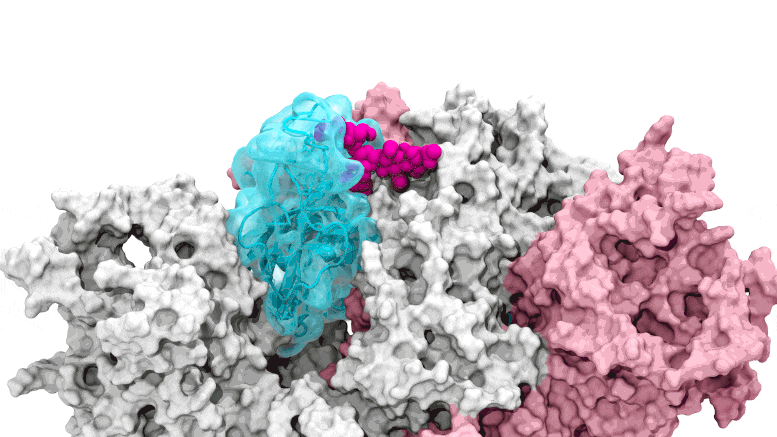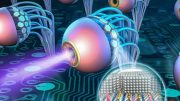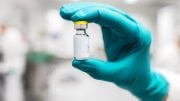
The glycan gate opens: Supercomputing-driven simulations depict the glycan N343 (magenta) acting as a molecular crowbar to pry open the SARS-CoV-2 spike’s receptor binding domain, or RBD (cyan), from a “down” to an “up” position. Credit: Terra Sztain, Surl-Hee Ahn, Lorenzo Casalino (Amaro Lab, UC San Diego)
Supercomputing-derived movies reveal details of deceptive sugar coating on spike protein, presenting new possibilities to block cell entry and infection.
Since the early days of the COVID pandemic, scientists have aggressively pursued the secrets of the mechanisms that allow severe acute respiratory syndrome coronavirus 2 (SARS-CoV-2) to enter and infect healthy human cells.
Early in the pandemic, University of California San Diego’s Rommie Amaro, a computational biophysical chemist, helped develop a detailed visualization of the SARS-CoV-2 spike protein that efficiently latches onto our cell receptors.
Now, Amaro and her research colleagues from UC San Diego, University of Pittsburgh, University of Texas at Austin, Columbia University and University of Wisconsin-Milwaukee have discovered how glycans—molecules that make up a sugary residue around the edges of the spike protein—act as infection gateways.
Published August 19 in the journal Nature Chemistry, a research study led by Amaro, co-senior author Lillian Chong at the University of Pittsburgh, first author and UC San Diego graduate student Terra Sztain, and co-first author and UC San Diego postdoctoral scholar Surl-Hee Ahn, describes the discovery of glycan “gates” that open to allow SARS-CoV-2 entry.
“We essentially figured out how the spike actually opens and infects,” said Amaro, a professor of chemistry and biochemistry and a senior author of the new study. “We’ve unlocked an important secret of the spike in how it infects cells. Without this gate the virus basically is rendered incapable of infection.”
Supercomputing-driven simulations depict the glycan N343 (magenta) acting as a molecular crowbar to pry open the SARS-CoV-2 spike’s receptor binding domain, or RBD (cyan), from a “down” to an “up” position. Credit: Terra Sztain, Surl-Hee Ahn, Lorenzo Casalino (Amaro Lab, UC San Diego)
Amaro believes the research team’s gate discovery opens potential avenues for new therapeutics to counter COVID-19 infection. If glycan gates could be pharmacologically locked in the closed position, then the SARS-CoV-2 virus is effectively prevented from opening to entry and infection.
The spike’s coating of glycans helps deceive the human immune system since it comes across as nothing more than a sugary residue. Previous technologies that imaged these structures depicted glycans in static open or closed positions, which initially didn’t draw much interest from scientists. Supercomputing simulations then allowed the researchers to develop dynamic movies that revealed glycan gates activating from one position to another, offering an unprecedented piece of the infection story.
“We were actually able to watch the opening and closing,” said Amaro. “That’s one of the really cool things these simulations give you—the ability to see really detailed movies. When you watch them you realize you’re seeing something that we otherwise would have ignored. You look at just the closed structure, and then you look at the open structure, and it doesn’t look like anything special. It’s only because we captured the movie of the whole process that you actually see it doing its thing.”
“Standard techniques would have required years to simulate this opening process, but with my lab’s ‘weighted ensemble’ advanced simulation tools, we were able to capture the process in only 45 days,” said Chong.
The computationally intensive simulations were first run on Comet at the San Diego Supercomputer Center at UC San Diego and later on Longhorn at the Texas Advanced Computing Center at UT Austin. Such computing power provided the researchers with atomic-level views of the spike protein receptor binding domain, or RBD, from more than 300 perspectives. The investigations revealed glycan “N343” as the linchpin that pries the RBD from the “down” to “up” position to allow access to the host cell’s ACE2 receptor. The researchers describe N343 glycan activation as similar to a “molecular crowbar” mechanism.
Jason McLellan, an associate professor of molecular biosciences at UT Austin, and his team created variants of the spike protein and tested to see how a lack of the glycan gate affected the RBD’s ability to open.
“We showed that without this gate, the RBD of the spike protein can’t take the conformation it needs to infect cells,” McLellan said.
Reference: “A glycan gate controls opening of the SARS-CoV-2 spike protein” by Terra Sztain, Surl-Hee Ahn, Anthony T. Bogetti, Lorenzo Casalino, Jory A. Goldsmith, Evan Seitz, Ryan S. McCool, Fiona L. Kearns, Francisco Acosta-Reyes, Suvrajit Maji, Ghoncheh Mashayekhi, J. Andrew McCammon, Abbas Ourmazd, Joachim Frank, Jason S. McLellan, Lillian T. Chong and Rommie E. Amaro, 19 August 2021, Nature Chemistry.
DOI: 10.1038/s41557-021-00758-3
The full author list includes: Terra Sztain, Surl-Hee Ahn, Anthony Bogetti, Lorenzo Casalino, Jory Goldsmith, Evan Seitz, Ryan McCool, Fiona Kearns, Francisco Acosta-Reyes, Suvrajit Maji, Ghoncheh Mashayekhi, J. Andrew McCammon, Abbas Ourmazd, Joachim Frank, Jason McLellan, Lillian Chong and Rommie Amaro.









It’s be great if there really is a way to “lock” the virus from infecting cells. But there’s another path to take after the virus gets into cells. And this view explains why some coronaviruses are so much more infectious than others.
All the coronaviruses and all their variants have different protein spikes, with Delta having one that’s more efficient at getting around the vaccines. But the real problem is in the virus itself, not its protein shell, and why the most dangerous (MERS, SARS, and Covid-19) are so infectious. My independent research has found multiple one-in-a-million nucleotide sequence matches between all the coronaviruses and the human genome. Those sequences are the same as some of the loops of human tRNA. Using those loops and their amino acid code matches, viruses may be able to fool the nucleus membrane in cells to allow the virus to enter and associate with the human DNA, creating more opportunities for further infection. Our immune system may be compromised and may no longer be able to stop the virus and other diseases from attacking organs throughout the body. Vaccines that attack the virus protein shells while ignoring their contents are doomed to failure from the Darwin effect, but recognizing these loops suggests a possible approach to successful coronavirus vaccines. Only the infection process is considered in my work, not the innate virulence of the virus. For more info, check out this YouTube, Coronavirus – Using Your DNA Against You. https://www.youtube.com/watch?v=8dOIzD6ch8s